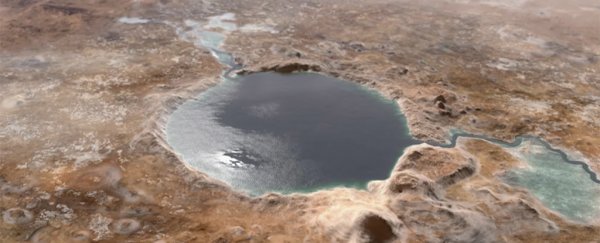Is there life on Mars? Has there ever been? It's one of the biggest questions we have about our planetary neighbor; now, research points to one particular part of the red planet that could have been able to harbor life several times across billions of years.
Through a thorough study of images captured by the Mars Reconnaissance Orbiter, planetary scientists have identified clay-bearing sediments across the northern Ladon Valles, the southern Ladon basin, and the southwestern highlands around Ladon basin – all part of the extensively cratered Margaritifer Terra area.
Clay points to the long-term presence of water, as it forms under neutral pH conditions with minimal water evaporation. The team thinks water flowed here from around 3.8 billion years ago up to around 2.5 billion years ago, a large stretch of Martian history.
"In addition, colorful light-toned layered sediments that display relatively low bedding dips and contain clays across 200 kilometers [124 miles] in distance are evidence that a lake was most likely present within Ladon basin and northern Ladon Valles," says Catherine Weitz, a senior scientist at the Planetary Science Institute in Arizona.
"The low-energy lake setting and presence of clays support an environment that would have been favorable to life at that time."
While it's not exactly proof of life – we'd need to go digging on Mars for fossils to truly confirm that – it does suggest conditions that might well have supported life. It's the latest piece of research to interpret conditions on Mars by what we can see of its surface and sediments.
The researchers think that clays originally formed around the higher ground above the Ladon basin, before being eroded by channels of water and transported downstream into a lake in the Ladon basin and the northern Ladon Valles.
According to the team, the most recent water flow would have been along the southwestern Ladon basin. The deposits here match another part of Mars, the Eberswalde delta, just to the south of the region covered by this study.
"Our results indicate that the clay sediments deposited by running water in Eberswalde were not unusual during this more recent time because we see many examples of similar young valleys that deposited clays in the region," says Weitz.
We know that there's ice on Mars, but the search for liquid water continues. This latest study backs up the idea that flowing water was once an extensive part of the Martian landscape – and it may have brought life with it.
How transitory or otherwise the presence of water has been on Mars is crucial to figuring out whether or not life could have been supported at some point. The distribution of clays and other rocks spotted by the researchers is consistent with water sticking around.
What's more, clays are sources of nutrients, and stabilizers to the environment around them. Put water, nutrients, and stable conditions together, and the chances of organisms being able to survive goes up significantly.
"Habitable conditions may have occurred repeatedly in the region, at least periodically, until relatively late in Mars history," write the researchers in their published paper.
The research has been published in Icarus.
